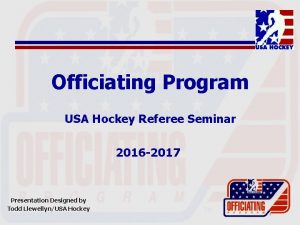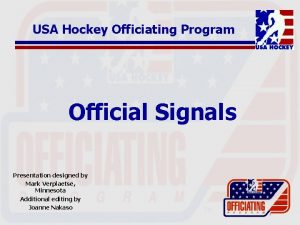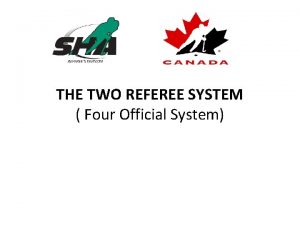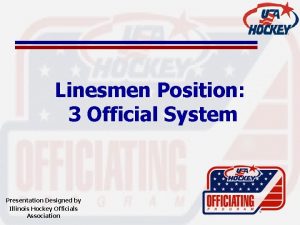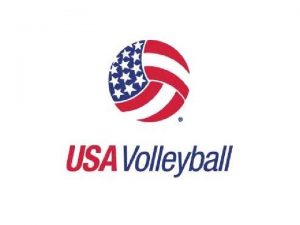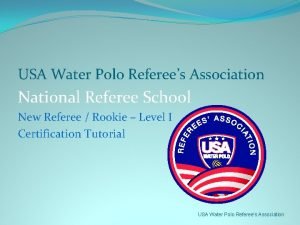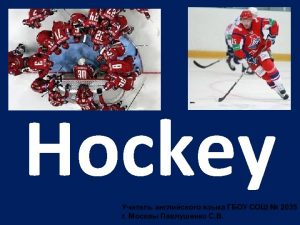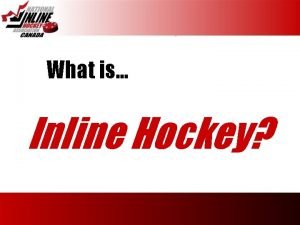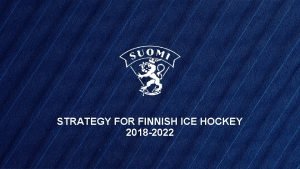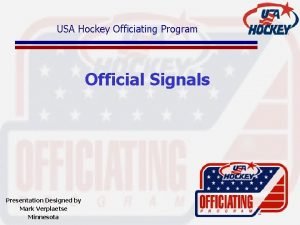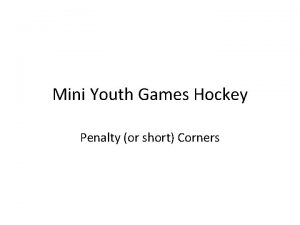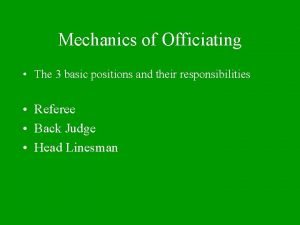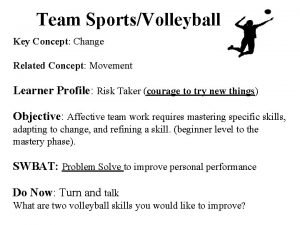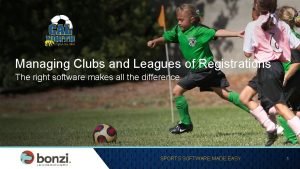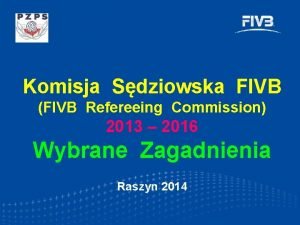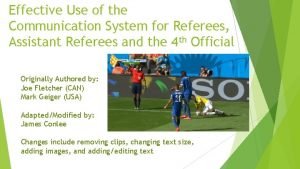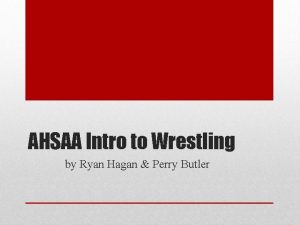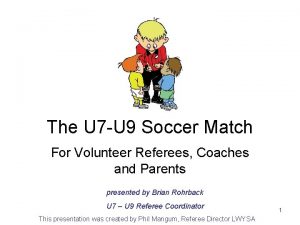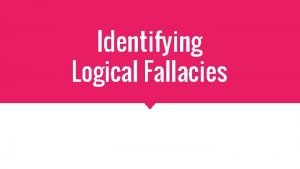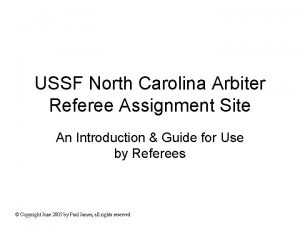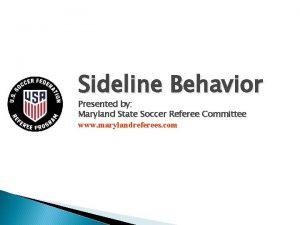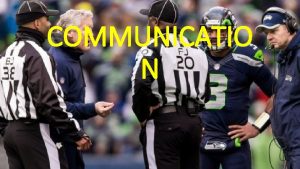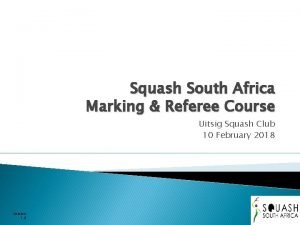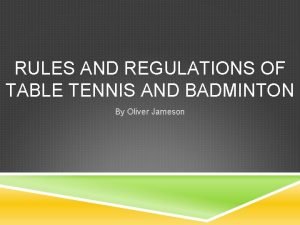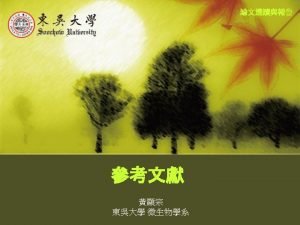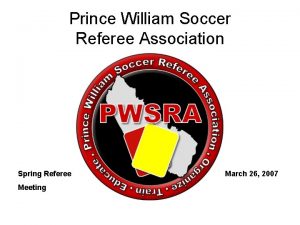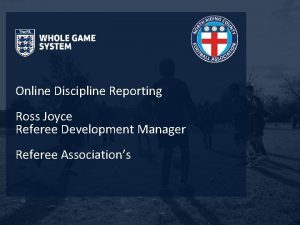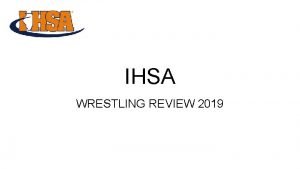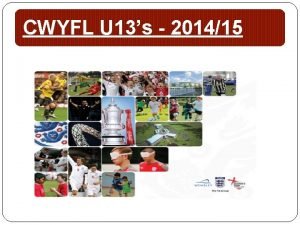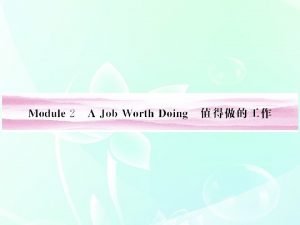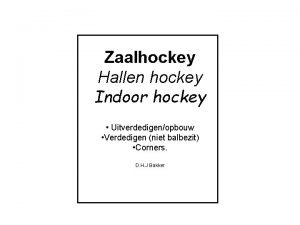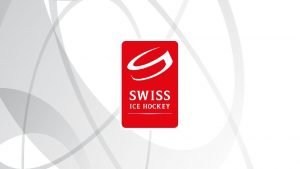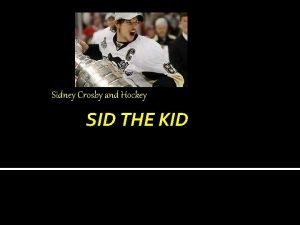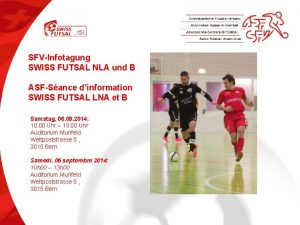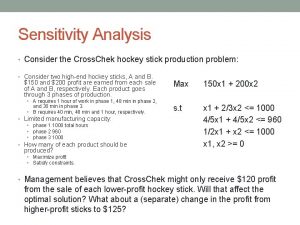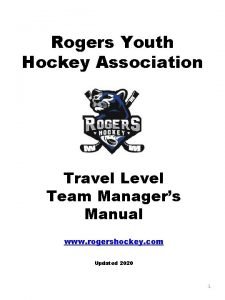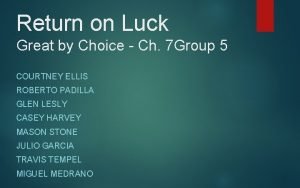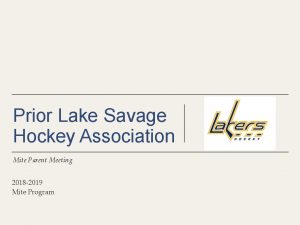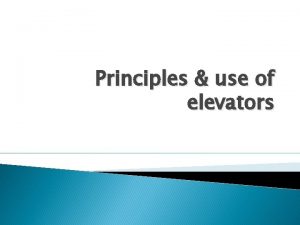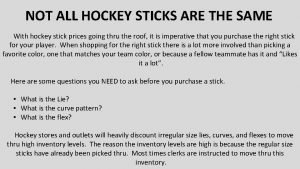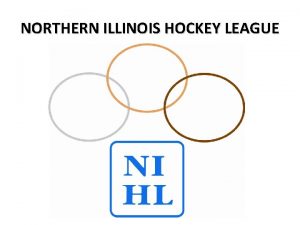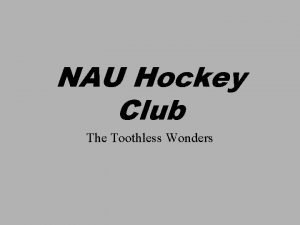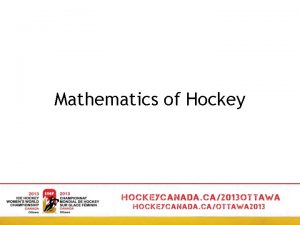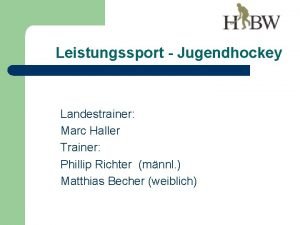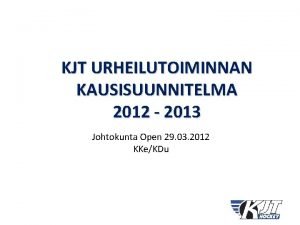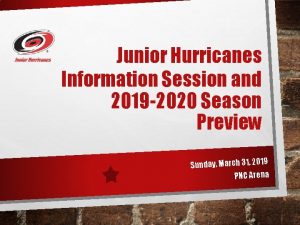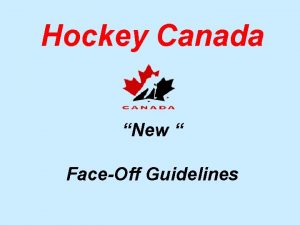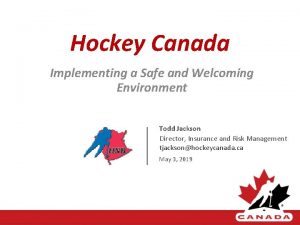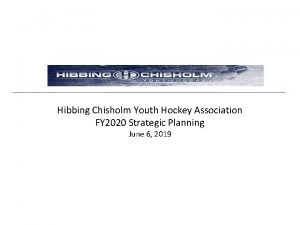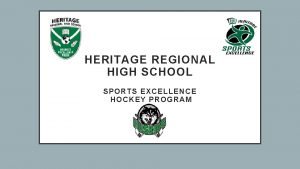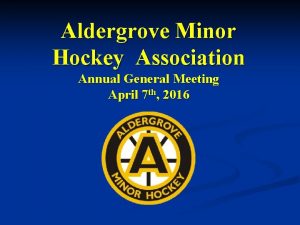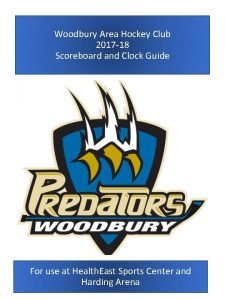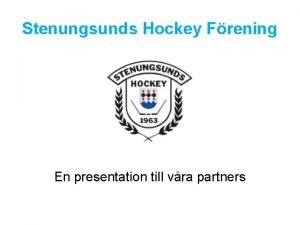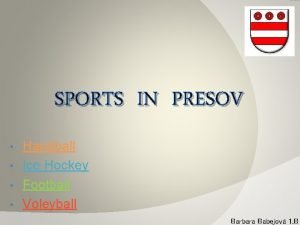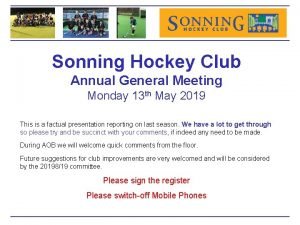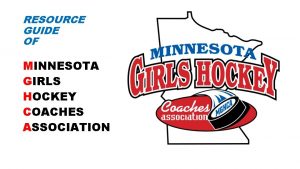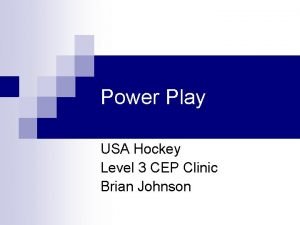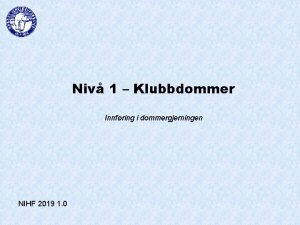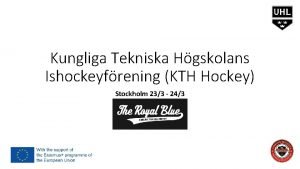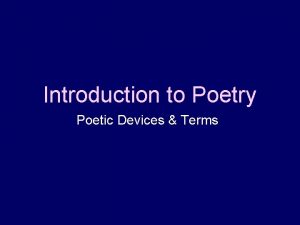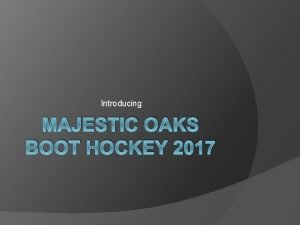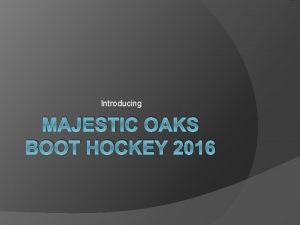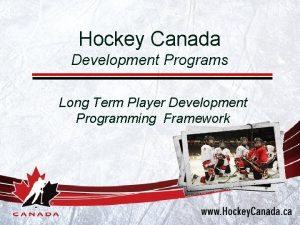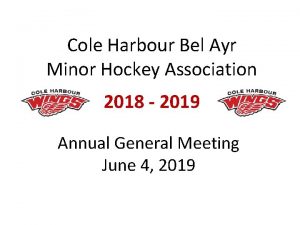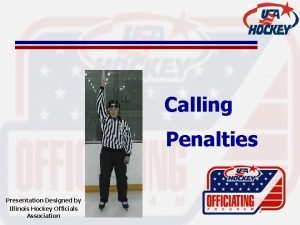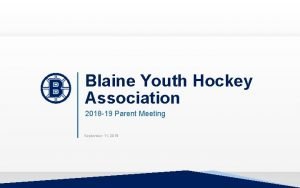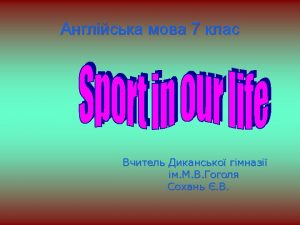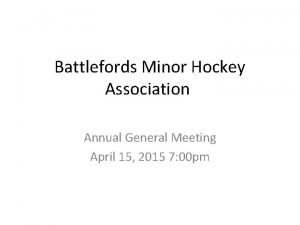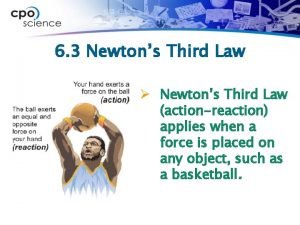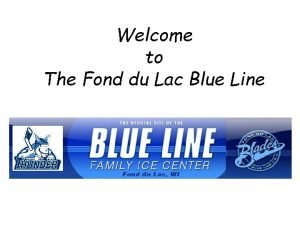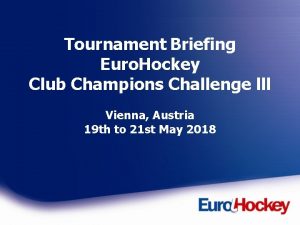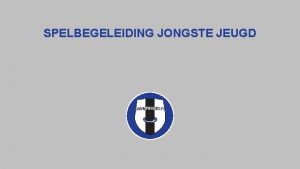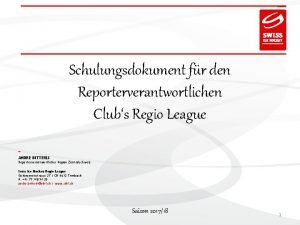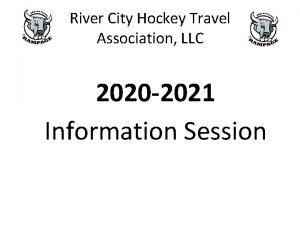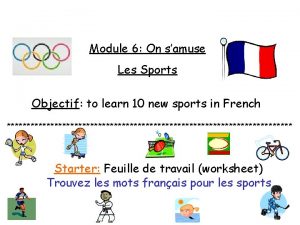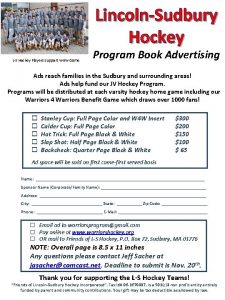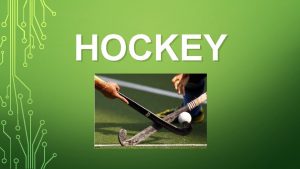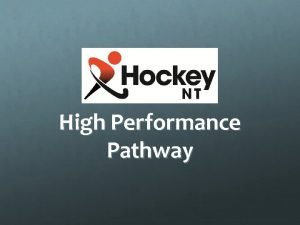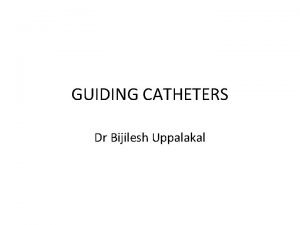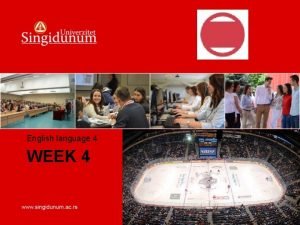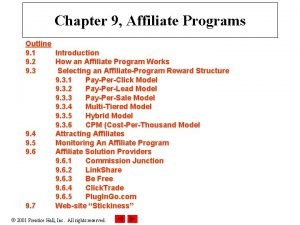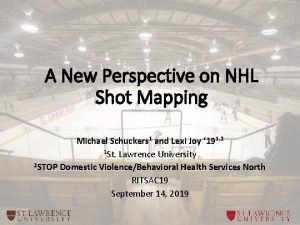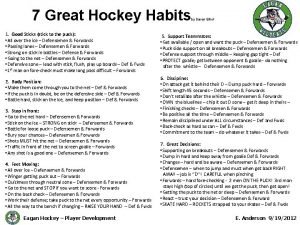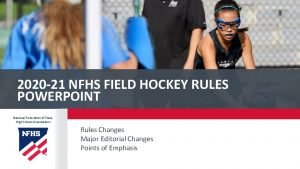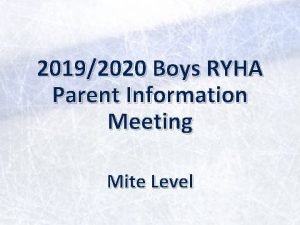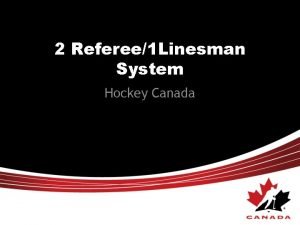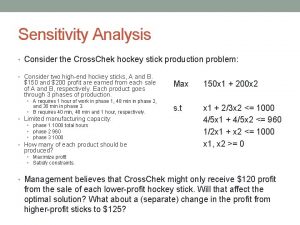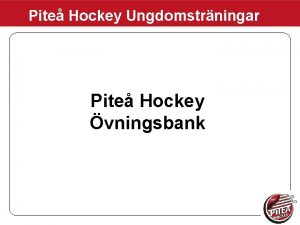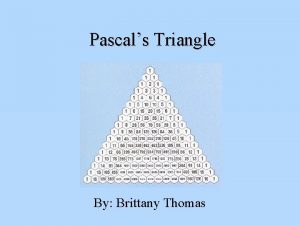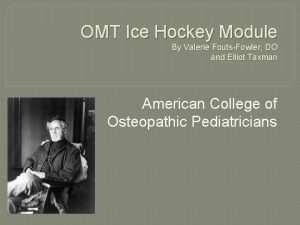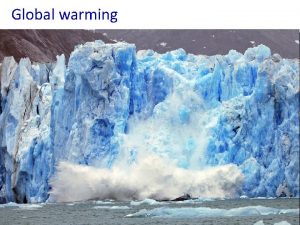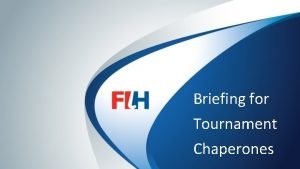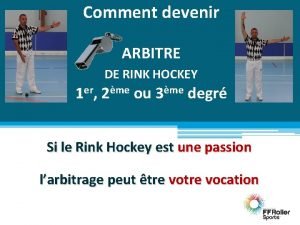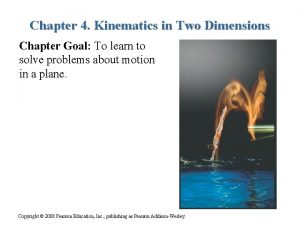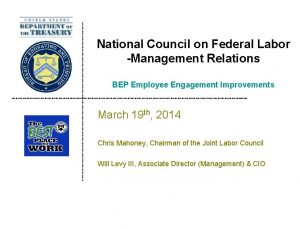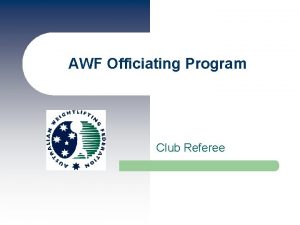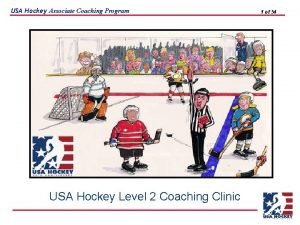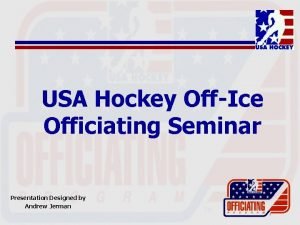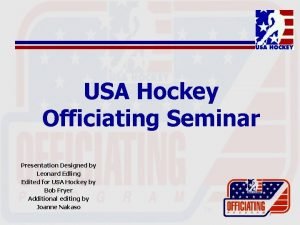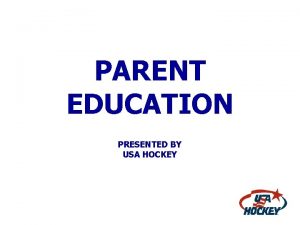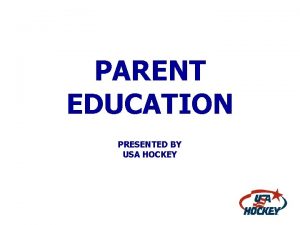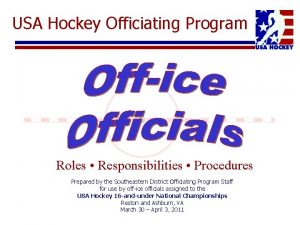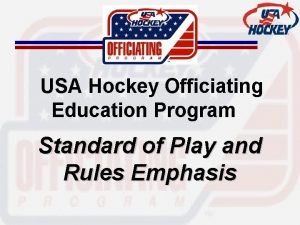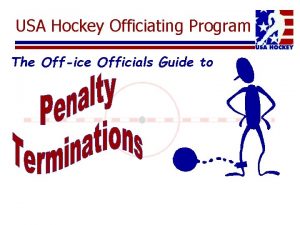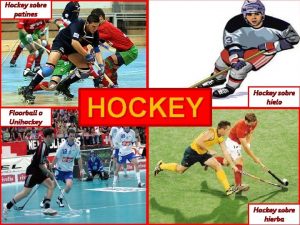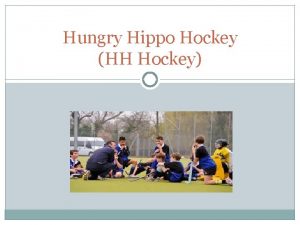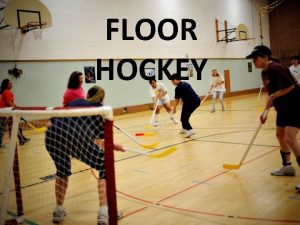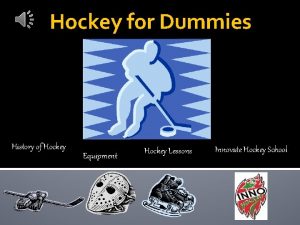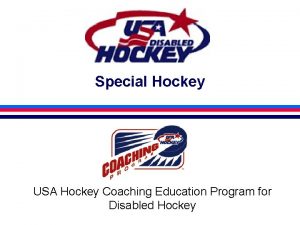Officiating Program USA Hockey Referee Seminar 2016 2017























































































































- Slides: 119

Officiating Program USA Hockey Referee Seminar 2016 -2017 Presentation Designed by Todd Llewellyn/USA Hockey

Purpose of Seminars? • Recommend Parents stay the first hour or so • Learn basics and fundamentals of officiating • Establish uniformity in officiating • Eliminate “creativity” in officiating • Staff Members Introductions

Agenda Time 11: 30 am 12: 00 pm 12: 45 pm 12: 55 pm 1: 25 pm 1: 40 pm 1: 50 pm 2: 05 pm 3: 15 pm 3: 35 pm 3: 45 pm 3: 55 pm 4: 05 pm 4: 25 pm 4: 35 pm 4: 45 pm 5: 15 pm 5: 30 pm 6: 30 pm Minutes 30 45 10 30 15 10 15 60 10 20 10 10 10 20 -30 15 15 60 Topic Registration Welcome, Introductions, and local subjects Registration requirements 2 Official System Off Sides Face Off Locations Icing Break Conducting Face Offs Calling Penalites - Signals Injured Players Awarding Goals and Assists Altercations Judgement Incident Reports Level 2 -3 Testing/New Officials Break (10) Equipment/Personal Appearance Dress for Ice Session Conclude • We will conclude at 6: 30 pm Instructor Llewellyn Scraibin S. Bryson D. Bryson Scraibin S. Bryson Scraibin D. Bryson Llewellyn D. Bryson

General • Turn Phones OFF! No Texting during meeting • Be on time • Take notes • Ask questions • Have fun and learn!

USA Hockey Overview/IHONC • National – USA Hockey • State – CAHA (California Amateur Hockey Association) • Local Officials – IHONC (Ice Hockey Officials of Northern California) • Pacific District Referee-in-Chief (RIC) West Coast Stevens • District/IHONC Evaluation Coordinator Randy Meyer • Seminar Coordinator Todd Llewellyn

Officiating Program • State Level • USA Hockey Dan Ellison CAHA Director of Officials Mark Mauro • Northern Cal IHONC President Todd Llewellyn Norcal Referee-in-Chief (RIC) Mark Mauro

Member Benefits • • Insurance (Medical and Liability) Details on back of Ref Card Development Opportunities Ø Ø Ø Ø Ø Summer Development Camps Regional and National Championships Junior Officiating Development Program District Officiating Seminars (CRS) International Officiating Instructor Training Grassroots Development (NAPHL) Evaluation Program Mentor/Shadow Programs • Resources (USA Hockey Officials resource page) Ø Ø Ø Officiating Manuals (Red for New Officials) Standards of Play and Rules Emphasis Videos USA Hockey – Hockey Magazine Stripes E-Newsletter

Local Officials Organization -IHONC • Registering with IHONC once you are USA Hockey Certified • How do you get paid? Direct Deposit into Checking or Savings Account (No Charge) • Profile – Update League (Club), Level and Team you play for • IHONC Rating (1 -6) – Ability on the Ice, different from USA • How do I get games? Scheduling Process – Website Availability • How do I return assignments? • All New Officials first 2 games scheduled training (No Pay), shadowed by experienced official • After 50 games worked “eligible” for next IHONC level • How do I get evaluated? • Shadow Program Details

Who do I contact? • Telephone numbers – Write in your Rule Books – – IHONC Registration/Payments/Scheduler Todd Llewellyn – Scheduler Adult/College Games Referee@ihonc-ca. com 1. 925. 785. 9608 – Mark Mauro – Scheduler All Youth Games/Tournaments – mmauro 1207@aol. com – 1. 650. 208. 4820 – Officials #’s on IHONC Web Site • 9

USA Hockey Registration Procedure • Complete Seminar Attendance (Today) • Complete Ice Session (Today) • Complete Open Book Test on line (USA Hockey Website) Must pass 40 out 50 Questions. Email from “Officiating Exam” • Complete on line (USA Hockey Website) Module Training • Adults Only (18+) Complete Safe Sport Training (On line USA) • Adults Only (18+) Complete Background Check (CAHA) • Once all of the above is completed, you will receive via mail from National Office of USA Hockey your Referee Card and Crest • Last Step – Must Register with the Local Officials Organization: Ice Hockey Officials of Northern California (IHONC)

IHONC Registration • www. ihonc-ca. com • Click Here

IHONC Registration • Click here

IHONC Registration

IHONC Direct Deposit • Click Here

IHONC Profile and Preferences • • What rinks will you work? What is your closest rink? How many games per month Who do you play for: League, Level, Team? Example: Norcal, TV Bant A • Website Notification Preferences

Game Assignments • Registration with the USA Hockey Officiating Program does not guarantee any official any game assignments. Officials are responsible to obtain their own game assignments from local game (IHONC) schedulers (Todd L or Mark M) as designated in each district. • Those officials that are more flexible with their schedules, will receive more assignments. We encourage each of you to work throughout the Northern California rinks. • Officials taking assignments from other officials, without the approval from a scheduler, they will not be paid, and subject to suspension.

Game Returns • Adult Officials to use the Google Game Trade Process. Once IHONC account is activated, you will be added to the distribution list. • If returning assignment with less than 72 hours, official required to CALL and EMAIL the Scheduler. • Youth Officials – “All Cancellations” officials are required to CALL and EMAIL Mark M for any cancellation.

Availability • Schedule Flexibility Rinks – Need to work Multiple Rinks (If only work “ 1” rink, assignments will be minimal) Change your schedule as often as your life changes. Please keep up to date!!!! • Levels – Adults- Need to work both Adult and Youth to develop Officials cannot officiate at they level they play. Youth officials can only officiate below the level the play • Extra games - Work Tournaments • 65% of games are played on Saturday and Sundays!!!!!

Evaluations • Request Evals through IHONC Web Site • Mandatory 3 -digit #’s on Official’s Helmets. Once Certified as USA Hockey Official, request through IHONC Every IHONC has a unique #

Positioning: 2 Man System • 20

Importance of Proper Positioning • Fundamental building block • Enables Official to see as much action as possible (enhancing judgment) • Provides Official with safe viewing areas • Keeps Official out of the way • Keeps Official out of “No-Man’s-Land” area that all officials must stay out of during play • 21

• Field of • Vision • 22

No-Man’s-Land Tootsie Roll • 23

Starting the Game • One Referee at center ice – (Facing Timekeeper) • Partner on opposite side of ice on center Red Line • Continually switching ends throughout the game • When puck is dropped, free Referee moves with the play • 24

Positioning During Play leaving Neutral Zone and enters Attacking Zone: • Free Official is at (inside determining edge) Blue Line before play • Official moves to Goal Line after making call at Blue Line • Deep Official is responsible for watching play • • Official on Blue Line watches in front of goal • Watches Behind Play • Watches Play Partner moves up to Blue Line • 25

Positioning During Play reverses and goes into opposite Attacking Zone: • Back Referee must wait at (inside determining edge) blue line to be sure play is leaving the zone • Back Referee moves to his line skating backwards • Makes call at Blue Line and follows play into zone • Partner skates quickly out of zone as players leave zone • Moves up to Blue Line • Play • 26

Positioning During Play in the Neutral Zone: • • Both Referees at their respective Blue Lines (skates in the Attacking Zone – determining edge) • Play Referees always diagonally across from each other • 27

Positioning During Face-offs End Zone face-offs: • Diagonally opposite on far Blue Line (10 feet from boards and 5 feet inside zone) • Maintains line until play leaves zone • Referee conducting face-off moves to Goal Line or out of zone with play • o r • 28

Positioning During Face-offs Neutral Zone face-offs: • Referee directly opposite side of the face-off • Must be ready to move in either direction with the play • Play goes toward his own end: follow and partner will respond • • Play goes toward partner’s end: follow and continue with play • 29

Positioning in the End Zone and on the Goal Line Skating into End Zone: • Skate hard into End Zone • No coasting keep feet moving • Get to Goal Line quickly, but only when the path is clear • Never cut through the face-off spot • 30

Positioning in the End Zone and on the Goal Line • Proper use of Home Base • Easy to move toward goal when shot on goal • • Easy to move back to corner when play moves to Referees side Following play out of zone • Move quickly out of zone so partner can release Blue Line • • Golden Triangle Anticipate the play leaving the zone • Home Base • 31

Post Game Positioning • At buzzer • Check ice first for altercations • During hand shake line • Referees on each side of line diagonally across from each other • Removed from players • X O • X O • 32

Retrieving the Puck Normal stoppages: • Referee in zone of stoppage spots face-off • Partner retrieves puck, hands off and returns to position • Normal Stoppages • 33

Retrieving the Puck After goal: • Referee in zone of goal reports goal and assists • Partner retrieves the puck and conducts ensuing face-off • 34

Retrieving the Puck After penalty: • Referee assessing penalty reports penalty • Partner checks for problems/potential altercations, then retrieves puck and conducts face-off • 35

Off Sides • 36

Positioning on the Blue Line • Official on the Blue Line • Inside the line as play enters Attacking Zone • Provides proper angle on play • Avoids interfering with Attacking players • Must get a clear view of the determining edge of the line • Partner moves into position • Must be ready to cover in case Official is knocked off line • Blue Line is part of zone from where the puck comes from • Determining edge is outside edge of line • 37

Determining Edge for Off-Sides Determining Edge is the outside edge of the Blue Line, furthest from the zone that the puck is in. • Puck is coming from Neutral Zone, so Blue Line is part of Neutral Zone • Puck not yet in Attacking Zone • • (No one can be Off-Side) • 38

Determining Edge for Off-Sides Puck must COMPLETELY cross the Determining Edge to be considered out of the zone. • Puck is coming from Attacking Zone, so Blue Line is part of Attacking Zone • Puck not yet in Neutral Zone • (Play is still On. Side) • 39

Signals Slow “delayed” whistle (U 14 and above levels only: • Flat palm, fingers together Point to face-off: • Full palm point with fingers together Washout: • Signal comes from chest then out • 40

Stopping Play for Off-Sides Puck carried into Attacking Zone with teammate(s) Off. Side: • Immediate whistle (no delay) and point to location of face-off • Official calling violation skates to spot of the face-off • Partner retrieves puck, hands it off and returns to position • 41

Stopping Play for Off-Sides Puck shot into Attacking Zone with teammate(s) Off-Sides: • Immediate whistle • In youth classifications below U 14 • Delayed whistle (delay signal) -Senior (Adult Games and Bantam 14 and above) • If puck goes directly to defending player • Puck not touched or played by Attacking player • 42

Stopping Play for Off-Sides Puck shot into Attacking Zone with teammate(s) Off. Sides (continued) Situation to nullify Off-Side (put arm down, no washout): • Defending team gains possession and gets puck out of zone • -OR- All Attacking players simultaneously clear zone Situation to blow whistle: • Attacking player forces opposing player with puck to retreat • Puck is touched or played by Attacking player • 43

Stopping Play for Off-Sides Calling Violation: • Official calling violation skates to the spot of the faceoff (where the puck was shot) • Partner retrieves puck, hands it off and returns to position Intentional off-sides: • Should be called in every case where the Official deems that where was no effort made or possibility of completing a legal play • Often done for the purpose of avoiding pressure from opponent • Onus is in puck carrier to be aware of position of teammates at ALL levels of play to create a legal play at the attacking blue line • 44

Special Situations Defending team shoots or plays the puck back into zone: • Players of Attacking team in Attacking zone are considered to be on-side Deflections back into zone with members of Attacking team in the Attacking Zone: • Always Off-Side • Off Referee • Off defending player • Off defective boards • 45

Face Off Locations • 46

• General Rules & End Zone Face-Offs • Never closer to the goal than the End Zone face-off spot • Never closer to the side boards than imaginary line connecting face-off spots • Never in middle of ice • 47

• Puck Frozen • Defending team: Nearest End Zone face-off spot • Attacking team: Nearest Neutral Zone face-off spot • 48

• Puck Frozen • Face-off along line perpendicular from boards on imaginary line connecting face-off spots • Attacking team in Attacking Zone: Nearest Neutral Zone Face • 49 -off spot

• Icing • Face-Off • Icing • 50

Face-Off Locations • Off-sides • Pass into zone: along imaginary line closest to spot from where puck was passed • Puck carried over: nearest Neutral Zone face-off spot • Puck frozen by Goaltender • Nearest End Zone spot to where puck was last shot or played • Penalty Call • Where puck was last played - along imaginary line • Attacking team in Attacking Zone: nearest Neutral Zone face-off spot • 51

Puck Shot Out of Rink • Stopping play • Any Official may stop play • Ensuing face-off • Official who stops play spots face-off • Partner retrieves puck • 52

RULE CHANGE ALERT 9 YEARS AGO! • If the official erred in making an icing call • Last play face-off (nearest end zone face-off spot) shall occur • Infringement of a rule causes a stoppage • If offending team would gain a territorial advantage, faceoff will be a ‘last-play’ face-off spot • 53

Icing • 54

Calling Icing Criteria for calling icing: 1. Puck shot from behind center Red Line • Center Red Line part of zone from where the puck comes • Determining edge is outside edge of line 2. Crosses opposing teams Goal Line 3. Puck not touched beyond center Red Line 4. No chance to be played by defending team • Not including Goaltender • 55

Calling Icing Mechanics of making call: • Back Official • Initiates icing by signaling slow whistle • Skates to cover partner’s Blue Line • Front Official • Acknowledges signal and skates into Attacking Zone • Blows whistle and raises arm when puck crosses Goal Line • Initiates call only when Back Official doesn’t see (one arm pump) • 56

Calling Icing After blowing the whistle: • Back Official • • Points to face-off location (end zone) Skates (watching players) to face-off spot Three strides, then turns backwards Icing signal at top of circle • Front Official • Retrieves puck, hands off and returns to position • Referee (3 official system) • Uninvolved in Icing • After whistles skates as deep as furthest attacking player • 57

Icing Signals • Slow “delayed” whistle Flat palm, fingers together (thumb in) • Icing Arms folded at chest, elbows pointed out • -OR- Washout Signal comes from chest then out • Point to face-off location Full palm point with fingers together (thumb in) • Release signal Arm extended out from side pointing diagonally down • 58

Washing Out Icing Infractions Mechanics of washing out play: • Back Official • Initiates icing • Cannot washout once play crosses center Red Line (unless shorthanded realized) • Follows to cover partners blue line • Front Official • • Makes call Washes out with verbal “NO” Continues to goal line (2 official system) Returns to blue line, releases partner (3 official system) • 59

Basic Icing Judgment: Situations • Defending player has an opportunity to play puck, but doesn’t – Washout • Puck crosses through Goal Crease – Still Icing • Puck deflected before crossing center Red Line – Icing if by shooting team – No Icing if by defending team • Puck touched after crossing center Red Line – No Icing if touched by either team • 60

Lunch Time – 60 Minutes • 61

Conducting Face Offs • 62

Officials Stance • Feet shoulder width apart • Shins parallel • Back and spine straight • Puck held in non-whistle hand • Puck hand forearm rests on hip bone • Head up and looking forward • 63

Holding the Puck • Two accepted methods • Thumb on top, forefinger along the side • Thumb and small finger on the side, other finger tips on top • Thumb must remain in contact with puck • Officials should try different techniques • Both players must have an equal view of the puck • Puck must always land flat • Face-off should be fair • 64

Dropping the Puck • Officials must be ready first • From belt buckle-Simultaneous out and down motion • Bend knees as puck starts first • Puck must land flat and remain stationary • Puck must land on center of face-off spot • Do not flick wrist prior to puck drop • Push the puck to the ice – avoid throwing puck down • 65

Players Positions • Official conducting face-off blows whistle at the conclusion of the line changes (after the Referee drops his arm) • • • Players have 5 seconds to line up If bit lined up 5 seconds due to slow change – line change / delay of game issue If all players lined up but center(s) – puck may be dropped after proper communication Integrity of face-off should not be compromised If players are set prior to 5 seconds – puck should be dropped • Centers • • • Attacking players stick down first Visiting players stick down first at Center Ice Stick stationary on white half moon When no spot exists - one stick length apart Shoulders square with end boards • 66

Players Positions • Other players • • Same side of circle as Center Outside of circle: includes sticks On their side of the hash marks At least 15 feet from Centers • Which official is responsible for which players? • Official conducting face-off • Centers and players in front of him • Partner • Players behind the official conducting the face-off • 67

Moving into Position After Face-Off 1. Drop puck 2. Pause to view play 3. Look behind you 4. Back to side boards 5. Keep play in front of you 6. Proceed to position facing play (2 or 3 official system) 7. Hustle only when clear to move • 68

Center Ice Face-Off Technique • Start of period • Signal Goalkeepers • Face and signal Timekeeper • Ensure clock is properly set • Following a goal • Face the players’ benches • Watch for potential problems • 69

Handing the Puck to your Partner Hand shake technique: • Place the puck flat in palm of partner • Receiving official closes hand firmly on puck • Professional look when clean and crisp • Everyone is watching you during this time • Never toss the puck to partner • 70

Calling • Penalties • 71

• What’s the call Ref ? ? • 72

Procedure for Calling Penalties • Penalty signals are vital • Penalty by team in possession of puck • Immediate whistle • Penalty by team not in possession of puck • Delayed “slow” whistle • When offending team gains possession and control of puck, sound whistle • 73

• Good signals are the Key • STOP • LOOK • ASSESS • 74

Assessment Procedure • Point to player (look past player) • Open palm, closed fingers • Verbalize number and color • Signal and verbalize infraction • Do not indicate type of penalty (minor, major, etc. ) • 75

Reporting Procedure • 3 strides forward then backwards to the penalty bench • Watch penalized player and others • Stop at penalty bench 8 -10 Feet from Glass • Signal and verbalize infraction, repeat number, color, infraction and signal • Proper cadence through entire procedure • 76

Blowing the Whistle • One loud, sharp blast – never more than one • Whistle out of mouth until ready to blow Stand still: at chest Skating: at side • Each stoppage with same intensity regardless if infraction or reason for stoppage • 77

Penalty Signals Demonstration of Penalty Signals (Time to stand Stretch) • 78

Do’s and Don'ts of Penalty Assessment • • • Slow, controlled cadence when all attention is on official No thumbs out Away from face (TV zone) No skating through signals No hurrying through signals No facial expressions No creative signals Never tell player minor or major on initial assessment Always repeat signal at Penalty Bench • 79

Verbal Communication Importance of verbal communication during penalties: • Explains penalty reason • Official should briefly explain to player (younger age groups only) • Be brief and to the point • Speak to Captains • Coaches when necessary • Other reasonable players also • 80

Special Situations • Bench Minor penalties • • Goaltender penalties (Minor, Major, Misconduct only) • • Served by any player except a goalkeeper Served by a player on the ice at the time of infraction Injured player • • Substitute player to serve penalty Once injured player returns, he must take his place in Penalty Box • Minor plus major, misconduct game misconduct, etc. • Additional player on penalty bench till minor expires • Major plus major, misconduct, game misconduct, etc. • Additional player on penalty bench till major expires • 81

Injured Players • 82

Stopping Play Thought to be serious injury: • Stop play immediately • Err on the side of caution Not a serious injury: • Stop play when team of injured player gains possession of the puck • Monitor injured player while play continues Always err on the side of safety! • 83

Once Play has been Stopped • Closest Official immediately skates to injured player • Partner(s) monitor other players • Motion Coach/Trainer onto ice to assist injured player • Monitor injured player until Coach/Trainer arrives • Do not try to move player or remove equipment • Verbally calm injured player and assess injury • 84

Once Play has been Stopped • Move away when Coach/Trainer arrive • Let them attend to injured player • Stay close enough to provide emergency assistance • But far enough away to prevent unnecessary verbal abuse • Allow time to assess injury before removing player from ice • If play was stopped for injured player: • Player must leave the ice, and may not return until after the next face-off has been completed • 85

Potential Head Injuries • Make note of any hard contact to the head (boards, ice or opponent) • Be aware of any noticeable symptoms of head trauma • • Unconsciousness Dizziness Loss of balance Slurred speech • Mention to coach the potential for head injury if contact with head occurs and/or symptoms are noticed on the ice • The responsibility then becomes that of the coach to properly monitor and remove player from game • 86

Awarding Goals and Assists • 87

Awarding Goals • Puck must completely cross the Goal Line • Goal credited to player who propelled the puck into opponents’ goal • Puck enters goal as a result of action by a defending player • Last player from scoring team to legally play the puck is credited with goal – no assists awarded • 88

Awarding Goals • Goal credited to attacking player who deflected puck into opponents’ goal • Goal shall be disallowed when • Puck strikes an Official and enters directly into the net • Puck is kicked by an attacking player and enters the goal either directly, or after being deflected off another player (of either team) • Puck is illegally (hand, foot) directed by an Attacking player and enters the goal • Puck is propelled or directed into the net by a high stick • 89

Awarding Assists • Assist(s) credited to player(s) taking part in the play immediately preceding the goal • Maximum of two assists per goal • Player cannot be credited with a goal and assist on the same goal • Examples: Blue #2 passes to blue #7, who then passes to blue #33, who then passes back to blue #7 and he then shoots and scores. Who gets the assists? Red #88 passes to Red #44, who then passes to Red #22 who shoots the puck on goal and Red #88 picks up the rebound and shoots and scores. Who gets the assists? • 90

Procedure for Awarding Goals and Assists • Referee or front Official is responsible for awarding goals and assists • May ask for help from partner(s) • When goal is scored • Referee should point with non-whistle hand in the direction of the Goal net • Referee should blow the whistle at the same time • 91

Procedure for Awarding Goals and Assists Reporting procedure: 1. Skate 3 strides forward, then backward to the Scorekeeper’s Bench (watch all players) 2. Stop at Scorekeeper’s Bench (8 -10 feet out) 3. Report player number to be credited with the goal followed by the assist(s) 4. Skate to proper position for Center Ice face-off • Partner will retrieve puck and conduct face-off (2 -man system), front Linesman in 3 -man system • 92

Disallowed Goals • Blow whistle and immediately give washout signal • Don't give washout signal if the puck remains in play (i. e. hits the post) • Report reason why goal was disallowed to game Timekeeper/Scorekeeper • 93

Altercations • 94

Altercations • Awareness • Good awareness will prevent most altercations • Anticipate potential problems between players • Hustle and control areas that lead to altercations • 95

Altercations • Safety of players and officials are top priority • Instruct other players to benches or goal crease (goalkeeper only) • Move equipment (sticks, gloves, etc. ) out of the area • Remove whistle from your hand • Communicate with partner • Never enter an altercation by yourself • Never grab player from behind – why? • Wait for fight to slow down or one player to gain an advantage • Be cautious of skate blades, face masks and other sharp objects • Talk to players, let them know you are there and fight has ended • 96

Altercations • Intervening • Communicate with partner (“I got Blue”) • One arm over the top, one arm underneath, squeeze together • Work your way between players (officials are back to back) • Once separated, let go, but stay in between players • Escort your player all the way over to the penalty bench • Escort suspended players off the ice at a time • 97

Judgment • 98

Officials are Teachers • Enforcement of the rules will teach the playing rules at lower levels of hockey to: • Players • Coaches • Parents • Spectators • Very little judgment is necessary in lower classifications • Enforcement with small or no “gray area” • 99

Officials are Teachers • Penalties are always penalties in Mite (ages 8 and below) and Squirt (10 and below) classifications • Penalties must always be assessed at the lower levels whether accidental or intentional – EXAMPLES: • Tripping • High Sticking • Body Checking or Roughing • Holding • Slashing • Head Contact • 100

Judgment Criteria for Calling a Penalty: • Blatant and obvious • Injury potential • Change of puck possession • Loss of scoring opportunity • 101

Judgment • Judgment comes into play more and is taught as Officials progress to higher levels • Rule knowledge is important at all levels of hockey • Have your Rule Book in your equipment bag to reference game situations • 102

Incident Reports • 103

Incident Reporting • What needs to be reported within 48 hours of your assignment • • • Match Penalties – Call Scheduler before submitting to confirm Game Misconduct Penalties Major Penalties that fall under Rule 411 (Progressive Suspensions) Other Penalties as determined by USA Hockey affiliate Only one report is needed to be submitted for the incident (one official submits). Match Penalties all on ice officials required to submit reports on IHONC website only. • Logging into the system – File IHONC report first • IHONC link: Under “Games”, Click on “File Incident Report” • Officials profile page at: www. usahockey. com • Once the official has logged into their profile, they can access the system to submit their game report or review previous reports • 104

Incident Reporting • Submitting the Report – USA Hockey Website • 105

Incident Reporting Submitting the Report - Continued • 106

Ice Session • 107

On Ice Drills • • Silent Warm-up Figure 8’s with Penalty Signals Face-Off Station Drill Calling Off-Sides Stations Calling Icing Calling No Ice Goal Line Movement with Penalty Call • 108

Silent Warm Up and On Ice Drills

Level 2 -3 Officials Test Time! • 110

Personal Appearance • 111

Looking the Part • Positive impression • Build credibility • Defines role as an official • Good looks complement good skills • Commands respect • 112

Personal Appearance • Facial Hair (adults groomed) • Hair • General condition/Fitness • 113

Off-Ice Dress for Regular Games • • • What to wear – Nice clothing – Neat, clean and tidy – No team jackets – Avoid T-shirts and jeans (if possible) Why? – Good first impression – Shows that officials take pride in work – Avoid appearance of favoritism Arriving at rink – 30 minutes prior to start of game – Avoid extended discussions or discussions about previous games – Be courteous, respectful and well-mannered at all times • 114

Officiating Equipment Needs • Necessary Equipment/Function/Qualities Mandatory • Helmet (black) – chin strap properly fastened • ½ Visor – Not tinted • Sweater (black/white stripes only, prefereed no under arm mesh) • Trousers (black) w/suspenders or belt • Skates (black) w/clean white laces. No Goalie Skates Optional (recommended) • Girdle protection • Cup and supported • Shin pads • Elbow pads • 115

Officials Supplies • Whistles – Acme Thunder or Fox (finger type) • Rule book (provided by USA Hockey) plus mobile app www. usahockeyruleboook. com • Basic Officials Manual – Red (provide by USA Hockey) • Equipment Bag • Tape • Telephone number of IHONC schedulers and Officials • Cut Skate Laces • Soap and Towel • 116

Proper On-Ice Attire • Black helmet w/ ½ Shield • Sweater • Well groomed neat appearance • Crest • Finger whistle • Clean white laces • Black trousers • Well maintained skates • 117

Equipment Purchase • 118

End of Slide Show Good Luck! • 119
 Usa hockey referee seminar
Usa hockey referee seminar Field hockey referee signals
Field hockey referee signals 4 man referee system hockey
4 man referee system hockey 3 man system hockey linesman
3 man system hockey linesman Usa volleyball
Usa volleyball Water polo referee signals
Water polo referee signals What is rinkball
What is rinkball Inline hockey vs ice hockey
Inline hockey vs ice hockey Ice hockey vs hockey
Ice hockey vs hockey Inline hockey vs ice hockey
Inline hockey vs ice hockey Field hockey signals
Field hockey signals Field hockey corners
Field hockey corners Usa hockey affiliates
Usa hockey affiliates Mechanics of officiating position
Mechanics of officiating position Basketball referee signals
Basketball referee signals 3 man basketball officials coverage
3 man basketball officials coverage Dead ball officiating in football
Dead ball officiating in football Usatf track and field
Usatf track and field Floor hockey program safety tips
Floor hockey program safety tips Referee hand signals in volleyball
Referee hand signals in volleyball Referee response letter
Referee response letter Qualities of a good referee
Qualities of a good referee Cwyfl referee
Cwyfl referee Fivb referee database
Fivb referee database Referee communication system
Referee communication system Ryan hagan referee
Ryan hagan referee Badminton faults
Badminton faults Second referee volleyball
Second referee volleyball Purdue owl logical fallacies
Purdue owl logical fallacies Arbiter referee login
Arbiter referee login Maryland soccer referee
Maryland soccer referee Wont bouncer therapist referee have advice
Wont bouncer therapist referee have advice Referee course in south africa
Referee course in south africa North carolina referee association
North carolina referee association Table tennis rules and regulations
Table tennis rules and regulations Refereed
Refereed Prince william soccer club
Prince william soccer club Ross joyce referee
Ross joyce referee Ihsa wrestling rules
Ihsa wrestling rules Cwyfl referee
Cwyfl referee The referee blew his whistle
The referee blew his whistle Hallen hockey
Hallen hockey Poems about hockey
Poems about hockey Feht hockey
Feht hockey Swiss field hockey
Swiss field hockey Delayed offsides hockey
Delayed offsides hockey Sid the kid crosby
Sid the kid crosby Sanitätskoffer hockey
Sanitätskoffer hockey 2000x1.03^2
2000x1.03^2 Rogers youth hockey
Rogers youth hockey Great by choice summary
Great by choice summary Prior lake savage hockey
Prior lake savage hockey Straight elevator works on which principle
Straight elevator works on which principle Lie on a hockey stick
Lie on a hockey stick Northern illinois hockey league
Northern illinois hockey league Nau hockey team
Nau hockey team Minnetonka youth hockey association
Minnetonka youth hockey association Field hockey dimensions
Field hockey dimensions Marc haller hockey
Marc haller hockey Kjt hockey
Kjt hockey Nagib ward hockey
Nagib ward hockey Hockey diamante poem
Hockey diamante poem Wennatex
Wennatex Ice hockey face off rules
Ice hockey face off rules Todd jackson hockey canada
Todd jackson hockey canada Hibbing youth hockey
Hibbing youth hockey Heritage regional high school hockey
Heritage regional high school hockey Floor hockey positions diagram
Floor hockey positions diagram Barringtons hockey
Barringtons hockey Indoor hockey skills
Indoor hockey skills Aldergrove minor hockey
Aldergrove minor hockey Woodbury area hockey club
Woodbury area hockey club Stenungsunds hockey
Stenungsunds hockey Presov hockey
Presov hockey Sonning hockey club
Sonning hockey club Richard dean anderson hockey
Richard dean anderson hockey Mshsca membership
Mshsca membership Cep level 2
Cep level 2 Dommerdagbok hockey
Dommerdagbok hockey Mosinee hockey club
Mosinee hockey club Kth hockey
Kth hockey Hockey alliteration examples
Hockey alliteration examples Majestic oaks boot hockey
Majestic oaks boot hockey Majestic oaks boot hockey
Majestic oaks boot hockey Hockey canada long term player development
Hockey canada long term player development Cole hocket
Cole hocket Ice hockey signals
Ice hockey signals Blaine youth hockey
Blaine youth hockey Cricket hockey billiards fencing
Cricket hockey billiards fencing North battleford minor hockey
North battleford minor hockey 3 newton's laws
3 newton's laws Blue line family ice center
Blue line family ice center Hockey lll
Hockey lll Balsport voor 5 tallen
Balsport voor 5 tallen Reporter sihf
Reporter sihf River city hockey
River city hockey Hockey sur glace
Hockey sur glace Friends of ls hockey
Friends of ls hockey Hockey deporte
Hockey deporte Hockey nt
Hockey nt Ikari right guide catheter
Ikari right guide catheter Language
Language Hockey affiliate programs
Hockey affiliate programs Hockey heat maps
Hockey heat maps Hockey habits
Hockey habits Field hockey markings
Field hockey markings Ryha open hockey
Ryha open hockey 3 man system hockey linesman
3 man system hockey linesman Videoscheidsrechter hockey
Videoscheidsrechter hockey Scott steffen hockey
Scott steffen hockey Hockey stick cross
Hockey stick cross övningsbanken hockey
övningsbanken hockey Pascal's triangle history
Pascal's triangle history Counter finger
Counter finger Irish hockey association
Irish hockey association Saul indian horse hockey player
Saul indian horse hockey player Global warming hockey stick
Global warming hockey stick Escort fih
Escort fih Formation arbitre hockey
Formation arbitre hockey A rocket-powered hockey puck moves
A rocket-powered hockey puck moves
